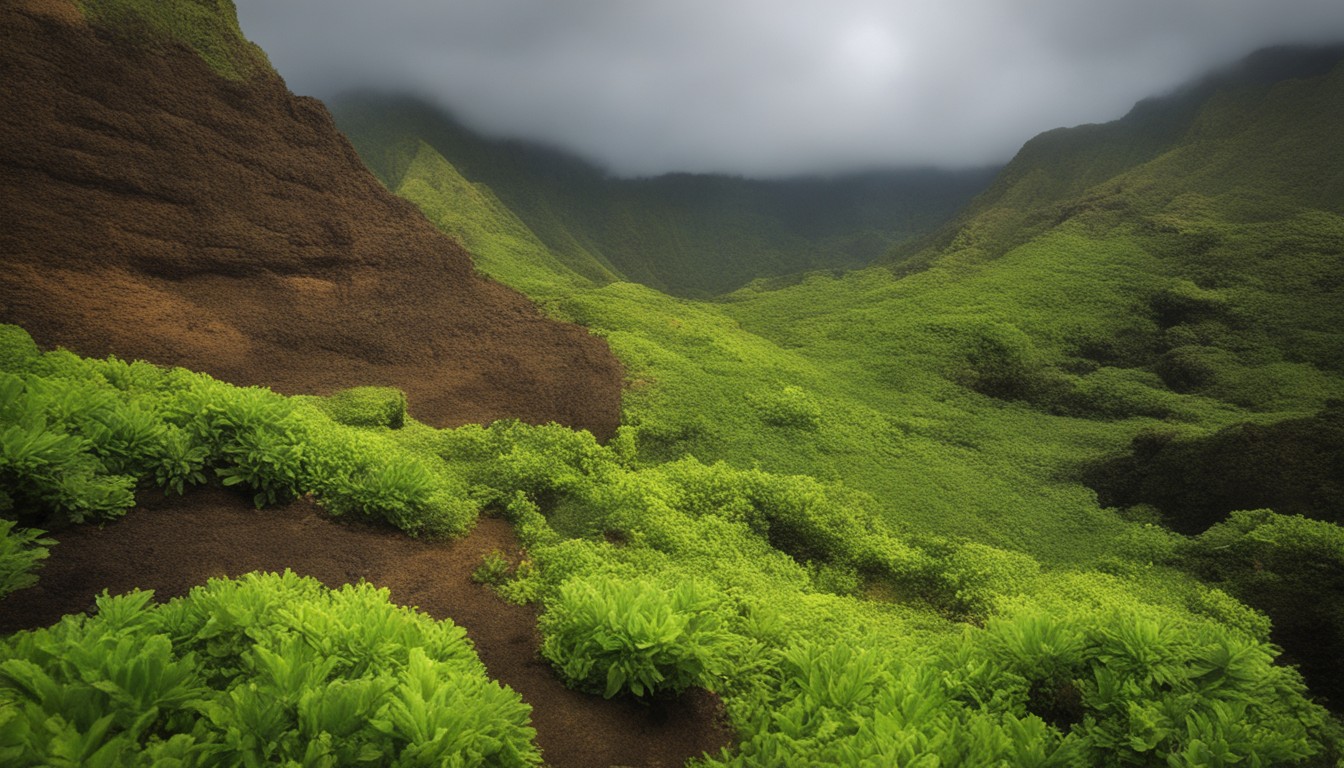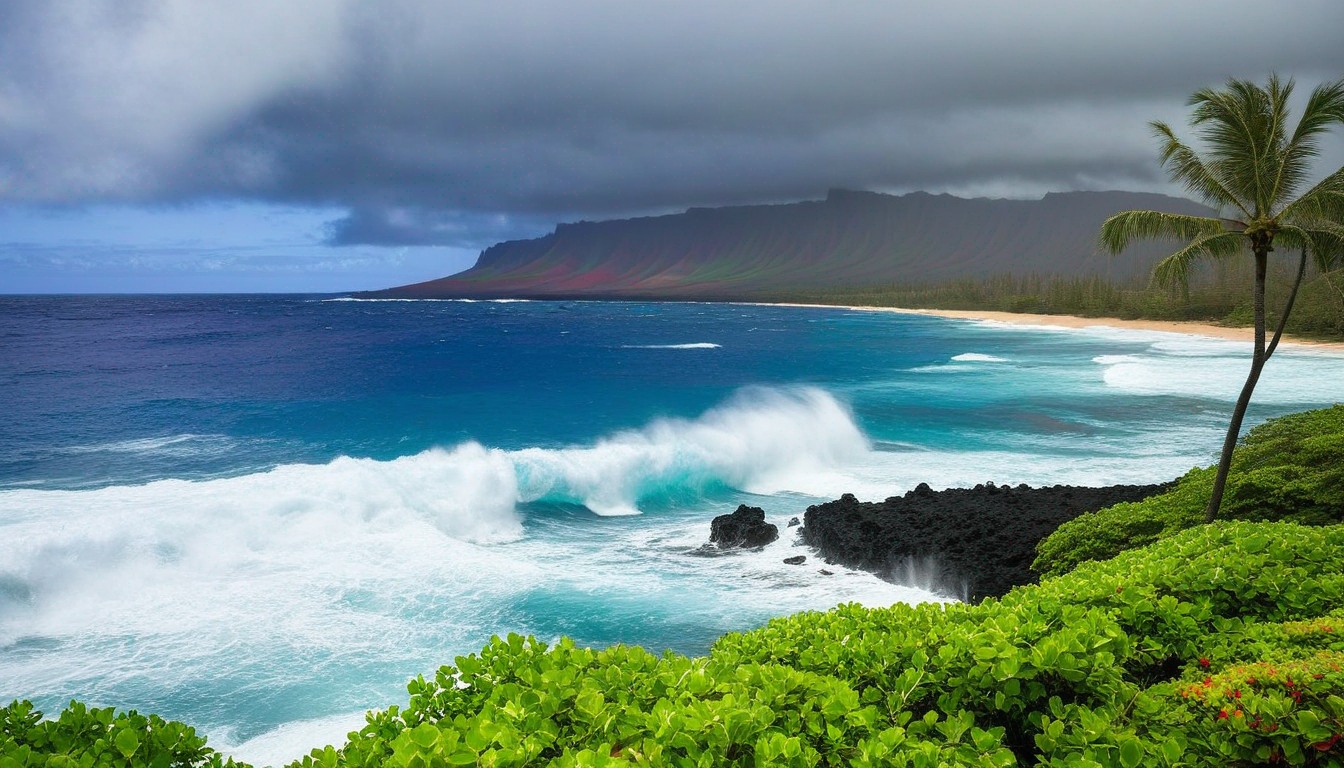Picture yourself on a Hawaiian beach, soaking up the sun with the sound of waves in the background. The last thing you want is dark clouds rolling in and running your dream vacation.
Is this even a likely scenario? When is the rainy season in Hawaii, and how intense is it?
Well, the rainiest months generally fall between November and March, but some islands have their exceptions. Plus, showers can happen sporadically year-round.
In this guide, I’ll break down Hawaii’s unique weather. You’ll also find insider tips for planning around the showers, finding the driest spots, and enjoying the best indoor activities if bad weather strikes. Let’s get to it!
Understanding the Seasons in Hawaii
Over the years, I’ve learned that there are only two seasons here. Summer lasts from May to October, and winter goes on for the rest of the year.
During the summer months, you can expect warm ocean temperatures perfect for snorkeling.

The interesting thing is that even in the winter months, Hawaii remains a mostly warm spot. Of course, Hawaiian winters are still different from summers in some ways!
For one, wintertime brings bigger waves and more rain. This is especially true from November to March.
So, the winter is what you’d call the “wet” season, but it rarely rains all day. You’ll usually just get quick passing showers here and there.
That said, I have to warn you that not all islands are equally dry!
Rainfall Estimates for Different Hawaiian Islands
Okay, so the amount of rain varies quite a bit between the Hawaiian islands and (within the same island, for that matter). But are there any weather patterns to follow?
Generally speaking, the northern shores and jungle areas tend to be rainier in the winter months than the dry, sunny leeward spots. Lucky for you, most resorts are located in relatively dry regions.
Let me give you a breakdown of the unique rainy seasons on the main islands:
Kauai
Kauai sees lots of rain all year long, but January takes the prize with a whopping 5.2 inches of rainfall. Meanwhile, June is the driest at just 1 inch.
It’s worth noting that the iconic Mount Waialeale on the island is one of the wettest spots on Earth, receiving 400+ inches of rainfall annually!
This flow feeds the Hanalei River on the north shore, which overflows its banks almost yearly. Some years, though, the water swelling level gets dangerously high.
For instance, in September 1996, 9 inches of rain fell in just 12 hours, flooding Hanalei town. Things got so bad that the only access point, the Hanalei Bridge, was closed!
However, that’s not what the weather is like all over the island.
Areas like Kekaha are mostly arid, receiving around 20 inches of rain per year. Similarly, spots like Hanamaulu only have 40–60 inches of annual rainfall.
In short, Kauai has a diverse microclimate!!
Maui
Maui has a longer rainy season from July through May, with March and January being the wettest months.
Note that the west and south shores are drier than the north’s rainforests. That’s because the mountains create a rain shadow effect, blocking the northeast trade winds.
As a result, tourist hot spots like Lahaina stay pleasantly dry year-round while the slopes get drenched.
Oahu
Oahu sees rain all year, but January averages the most rain, at 2.4 inches. Even during the winter season, you can still find sunny skies somewhere on the island!
Big Island
On average, the rainfall on Hawaii Island is heaviest in March. Yet, the weather can vary dramatically based on location.
For instance, the Lush Hilo sees the most rain in April, averaging 7.2 inches. Meanwhile, Kona averages just 4 inches in its peak rainy season in March.
Moloka’i and Lāna’i
The smaller islands of Lanai and Molokai experience similar rainfall patterns, with January being the heaviest month and June the driest.
The Impact of Rainfall on the Hawaiian Ecosystem
As a nature lover, I’m fascinated by how Hawaii’s rainy seasons shape the islands’ lush landscapes. The light rain is hardly a nuisance for tourists. But oh, how the native plants and animals have adapted to thrive in the wetter months!
From the lush forests to fish populations, Hawaii’s ecosystems depend on the vital rains of each wet season.
For one, Ohia trees become adorned with bright red lehua blossoms that attract nectar-feeding insects and native birds (like the dazzling ‘i’iwi). The tree canopies also capture rainwater to replenish the aquifers.
The damp rainforests? They’re an excellent spot for the islands’ frogs!
On the other side of the equation, the increased water level is important for the ‘O’opu (also called the Sandwich Island sleeper) fish. After all, a reduced water flow can limit the larvae’s chances of getting into the ocean.
Plus, the runoff water also transports nutrients into coastal waters!
Planning Your Trip Around Hawaii’s Rainy Season: 5 Practical Tips
Some folks can’t avoid the rainy season. Maybe it’s due to workloads or school vacation schedules. Either way, you can still have a blast if you plan well in advance.
Keep in mind that a little preparation goes a long way when visiting Hawaii during the wetter months!
Here are a few handy tips to help you make the most of your vacation during the islands’ rainy months:
1. Make Smart Choices for Your Packing List
If there are high chances of rain, bring lightweight items made from moisture-wicking fabrics. These will dry fast if you’re ever caught in a passing shower.
2. Pick Resorts in Drier Areas
Now that you know the rainfall patterns, you can book rooms in leeward resorts that sit in rain shadows.
However, I’d also recommend checking the area’s specific rainy season and the average rainfall before booking.
3. Head to the Sunny Side for a Day Trip
If it’s raining where you are, try driving to the opposite side of the island—it’s likely drier.
In this case, though, you need to take precautions, like de-fogging the windows.
You’ll need to focus on the road and avoid the puddles, too. So, it might be better to hire an experienced driver for the day.
4. Be Careful Around Waterfalls
Don’t swim under waterfalls right after big storms. Debris gets swept downstream with heavy rainfall!
That’s not to say that you need to avoid waterfalls altogether. You can go on a guided tour/hike.
Oahu’s Manoa Falls out-and-back trail is a popular pick, and it takes a round an hour. Just make sure your hiking shoes can handle some muddy grounds!
5. Choose a List of Plan-B Activities
You don’t have to sulk in your room just because it’s raining outside. Odds are, you’ll find a suitable indoor or outdoor activity nearby.
Of course, the possibilities change based on where you’re staying, but here are a few of my favorite rainy-day activities:
- Visit landmarks and museums like Bishop Museum, Iolani Palace, or Honolulu Museum of Art
- See shows at Hawaii Theater or Diamond Head Theater
- Attend events at the Blue Note Hawaii or Maui Arts & Cultural Center
- Learn hula dancing or Hawaiian crafts at resorts’ cultural centers
- Tour the Maui Ocean Center
- Relax with spa treatments
- Grab a poncho and go on a whale-watching tour (the humpback whale season runs from November to April, peaking around January and March)
Worst Weather in Hawaii: Hurricane Season and Tropical Storms

I’m often asked if hurricanes are a big concern on the islands. The truth is that intense hurricane strikes are quite rare, thanks to Hawaii’s location in the Central Pacific.
That’s because as storms move closer to Hawaii, the water cools, which often weaken storms before they arrive. Note that a hurricane needs warm waters (around 80°F) to sustain itself.
However, powerful storms can occasionally threaten the Aloha State, usually between June and November each year.
While brief daily rains are no big deal, hurricanes bring dangerous high winds and flooding.
Let’s look at some of the major Hawaii hurricane events over the years:
Hurricane Iniki – 1992
This catastrophic Category 4 hurricane caught the residents off guard and made landfall on Kauai in September 1992. It brought intense winds that damaged over 14,000 homes and killed six people along the way.
Some sources estimate that the total damage was worth $3 billion!
Interestingly, footage from Iniki was actually used in Steven Speilberg’s Jurassic Park—the crew were filming on Kauai at the time.
The good news is hurricane preparedness has improved dramatically since then.
Hurricane Iselle – 2014
The state had a long break from tropical cyclones, but Iselle changed the situation in 2014.
It made landfall as a moderate tropical storm on Hawaii Island, inducing 6–10 inches of rain and moderate flooding over most east-facing and south-facing slopes.
Hurricane Darby – 2016
Though it weakened along the way, Darby dumped heavy rain southeast of the Big Island at a rate of more than 5.4 inches per hour. The result was dangerous flash flooding.
Oahu was drenched with a 7-inch rainfall, too.
Hurricane Hector – 2018
Hector weakened from Category 4 to a tropical storm as it approached Hawaii.
Yet, the surf swelling was intense back then and got to 10–20 feet along the east and south-facing shores. But, thankfully, there were no casualties.
Hurricane Lane – 2018
Lane reached Category 5 but weakened significantly before breaking rainfall records on Hawaii Island. The volume of rainfall in some regions was 50+ inches!
Hurricane Douglas – 2020
Douglas was a Category 4 storm that got weaker before passing just north of Oahu in July 2020. Strong gusts downed trees, and the storm brought 1–3 inches of rain in most areas.
Hurricane Calvin – 2023
Calvin was the first cyclone threat to Hawaii since Douglas. Overall, Maui witnessed 7 inches of rainfall, and there were no serious damages.
Selecting the Best Time for a Hawaiian Vacation

Let’s just get one thing out of the way: There’s no truly bad time to visit Hawaii (unless there’s a hurricane warning, of course).
After all, Hawaii’s Tourism Score on WeatherSpark ranges between 8.2 and 6.5. For reference, this score is a metric that favors clear days with a perceived temperature of 65–80°F, and Honolulu tops the chart almost all year round!
Yet, certain months see better weather, fewer crowds, and cheaper prices.
The most pleasant weather falls between April and May, outside the main rainy season. Temperatures are warm and balmy without being excessively hot. Ocean conditions are calmer as well.
This is conveniently also the low tourist season. So, you can find decent flight and hotel deals. Similarly, October and September are ideal times to visit.
On the other hand, Summer draws more families on vacation but sees pricier airfare, and so does late December when schools are out for the holidays. But with strategic planning, you can find pleasant weather and affordable rates year-round, even in the peak seasons.
The Rainy Season Isn’t Too Bad for Travel, Either
Locals can notice a difference between “winter” and “summer,” but tourists are unlikely to observe much variation in temperatures. Thanks to Hawaii’s microclimates, rain is also quite localized.
That’s why Hawaii’s rainy period from November through March rarely deters visitors!
FAQs
Why is rainfall common in Hawaii?
Hawaii’s tropical climate, contours, and trade winds create ideal conditions for rainfall.
Ocean waters around the islands evaporate moisture into the air. As this moist air blows onto Hawaii’s mountainsides and rises, it cools and condenses into clouds. Further cooling at higher elevations causes the condensed water vapor to fall as frequent rain showers.
What months are dry in Hawaii?
While the dry season varies across islands, June typically has the lowest rainfall. May and July are also among the driest months.
What is the hottest month in Hawaii?
With anaverage of 81° F, August takes the title as the hottest month in Hawaii’s tropical climate.
That said, the variation between summer and winter temperatures remains minimal across most islands. Even in August, refreshing trade winds keep things from getting too steamy!
Final Thoughts
While Hawaii sees more rain from November to March, showers are often brief and isolated.
All in all, the wet weather is not a deal breaker. You just need the right preparation, the flexibility to move around, and a solid activity list!
Visitors might even grow to appreciate Hawaii’s wet season as an authentic part of the islands’ natural charm!
